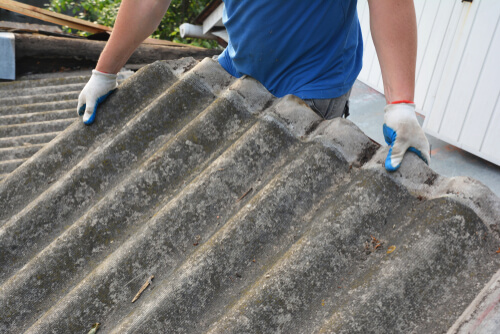When Was Asbestos Commonly Used?

Asbestos is a fiber that is durable, heat-resistant, and fairly cheap. It’s for these reasons that it was used widely from the 1920s to the 1970s, until the dangers of this naturally occurring mineral became fully understood and widely appreciated.
The fibers of asbestos can be deadly when they are inhaled. They become lodged in the abdomen, and the lining of organs such as the lungs and heart. Over time, this can cause a person to develop mesothelioma, a very aggressive form of cancer, and other asbestos-related diseases.
Due to the fact that asbestos was used so much, so long, and in so many products, there is still much of it around today, continuing to expose people and put their health at risk. If you have developed an illness due to asbestos exposure, contact The Law Offices of Michael P. Joyce, P.C., now for a free claim review.
Early Use of Asbestos
Asbestos occurs naturally in all parts of the world. Asbestos fibers dating back 750,000 years ago have been found by archaeologists. Even in ancient times, asbestos had many uses. In 4000 B.C., it’s believed asbestos was used as wicks in lamps and candles. It’s also thought that ancient Egyptians wrapped the body of pharaohs in asbestos cloth after they died. This was to prevent the bodies from deteriorating.
Asbestos use continued into later times, as well. In 1095, French, German and Italian knights used it as weapons in the First Crusade. They would fill bags with pitch and tar, then wrap them in asbestos and throw them over city walls. Later, in 1280, Marco Polo wrote about clothing he saw in Mongolia made from fireproof fabric.
In 1725, Benjamin Franklin brought a purse made of asbestos to England. By the 1800s, Italy was using asbestos to create its bank notes. In the 1850s, the jackets and helmets worn by the Parisian Fire Brigade were made of asbestos.
In the late 1800s, Canada opened the first asbestos mine. Shortly after, Finland also began mining the harmful fibers, followed by South Africa, Swaziland, and Zimbabwe. Shortly after, it would be mined throughout the globe.
Asbestos in Manufacturing
Even though asbestos mining dates back to ancient times, it was during the Industrial Revolution of the 1800s that the industry truly flourished. Due to the fact that the mineral was resistant to heat, chemicals, and electricity, it was useful in many industrial applications.
By the early 1900s, asbestos was intensely mined and manufactured. Between the years 1900 and 1910, asbestos production around the world tripled. By 1910, there were over 109,000 metric tons of asbestos mined around the world. Manufacturers used it to insulate steam engines, piping, and locomotives. Soon, asbestos could be found just about everywhere including in boilers, gaskets, cement, roofing materials, and brake pads in vehicles.
During World War II, the widespread use of asbestos continued. The United States government actually required that ships in the U.S. Navy and Coast Guard used asbestos as insulation. The use of the deadly mineral would continue for decades after the war though, with manufacturers using it in thousands of industrial and household products.
Asbestos in Houses
It’s believed asbestos was used in the construction of houses as early as the 1920s, when it was used mainly for plaster. Roofing and siding shingles were also made of asbestos cement during this time. Asbestos was also used in wall and ceiling joints, as well as in textured paint and textured ceilings.
Houses that were constructed between 1930 and 1950 likely still contain asbestos in the insulation.
Asbestos in Schools
Approximately half of all schools in the United States were constructed between 1950 and 1969. This was also a time when asbestos was added to almost every kind of building material because of its ability to withstand heat and fire, and because it was so durable.
According to the U.S. Environmental Protection Agency (EPA), most of the country’s primary, secondary, and charter schools still contain asbestos. This is particularly true for any school that was built before 1980.
When asbestos is left undisturbed, it does not pose a threat. However, when renovations are done, or structures within a school, such as walls, begin to deteriorate and break down, this causes asbestos fibers to be released into the air. When this happens, teachers, students, and anyone else present in the school are put at risk. It’s for this reason the EPA has also issued guidelines on how schools should spot and prevent asbestos hazards.
Asbestos Is Still Not Banned in the U.S.
The dangers of asbestos were documented as early as the 1930s. However, the United States government did not pass legislation regulating the use of asbestos until 1970.
In 1989, the EPA attempted to have the harmful product banned, but that ruling was overturned by the Fifth Circuit Court of Appeals in New Orleans in 1991. At that time, the courts were under immense pressure from the asbestos industry to allow it to continue to manufacture and distribute its deadly products.
Although over 50 countries have banned the use of asbestos, the United States is not one of them. The industry is now heavily regulated and government agencies continue to publish different guidelines. Still, the use of the harmful substance has declined in the country. In 2002, the last asbestos mine in the nation was closed. That effectively ended asbestos production in the country, although it is still found in millions of products.
As recently as June 2018, the EPA announced it would consider new uses of asbestos. It was a statement that was met with shock and outrage from those aware that there is no such thing as safe exposure to asbestos.
Were You Exposed? Call Our Massachusetts Asbestos Attorneys
Millions of people have been exposed to asbestos and are now developing deadly diseases such as mesothelioma and asbestos-related lung cancer. If you believe you were exposed and are now suffering from an asbestos-related illness, our Boston asbestos attorneys can help.
At The Law Offices of Michael P. Joyce, P.C., we know there are many forms of compensation available for people who have become sick from asbestos exposure. After reviewing your case, we can determine which route is appropriate for you, whether that is a trust fund, veterans’ benefits, or even a personal injury lawsuit.
Call us today so we can start working on your case. The claim review is completely free and confidential.

